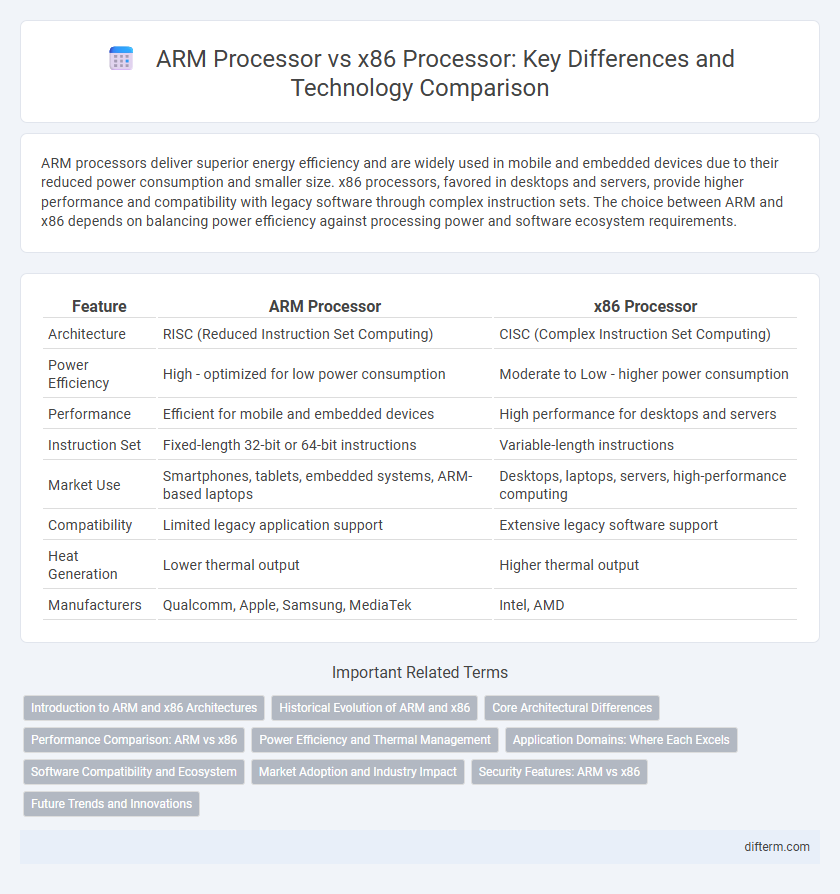ARM processors deliver superior energy efficiency and are widely used in mobile and embedded devices due to their reduced power consumption and smaller size. x86 processors, favored in desktops and servers, provide higher performance and compatibility with legacy software through complex instruction sets. The choice between ARM and x86 depends on balancing power efficiency against processing power and software ecosystem requirements.
Table of Comparison
| Feature | ARM Processor | x86 Processor |
|---|---|---|
| Architecture | RISC (Reduced Instruction Set Computing) | CISC (Complex Instruction Set Computing) |
| Power Efficiency | High - optimized for low power consumption | Moderate to Low - higher power consumption |
| Performance | Efficient for mobile and embedded devices | High performance for desktops and servers |
| Instruction Set | Fixed-length 32-bit or 64-bit instructions | Variable-length instructions |
| Market Use | Smartphones, tablets, embedded systems, ARM-based laptops | Desktops, laptops, servers, high-performance computing |
| Compatibility | Limited legacy application support | Extensive legacy software support |
| Heat Generation | Lower thermal output | Higher thermal output |
| Manufacturers | Qualcomm, Apple, Samsung, MediaTek | Intel, AMD |
Introduction to ARM and x86 Architectures
ARM architecture features a RISC (Reduced Instruction Set Computing) design that emphasizes power efficiency and simplified instruction execution, making it ideal for mobile and embedded devices. x86 architecture, based on CISC (Complex Instruction Set Computing), supports a wide range of instructions and is optimized for high-performance computing in desktops and servers. ARM processors excel in low power consumption, while x86 processors provide superior performance and compatibility with legacy software.
Historical Evolution of ARM and x86
The ARM processor architecture, developed by Acorn Computers in the 1980s, revolutionized the semiconductor industry with its RISC-based design emphasizing power efficiency and simplicity. In contrast, the x86 architecture, originating from Intel's 1978 8086 CPU, evolved through complex instruction set computing (CISC) principles to dominate desktop and server markets with high performance and backward compatibility. Both architectures have undergone significant advancements, with ARM focusing on mobile and embedded systems while x86 continues to lead in personal computers and enterprise environments.
Core Architectural Differences
ARM processors utilize a Reduced Instruction Set Computing (RISC) architecture, emphasizing energy efficiency and simplified instruction sets for faster execution per clock cycle. x86 processors employ a Complex Instruction Set Computing (CISC) architecture, featuring more complex instructions that can execute multi-step operations within a single command, enhancing performance in desktop and server applications. The ARM core's design prioritizes low power consumption and high efficiency, while x86 cores focus on raw processing power and backward compatibility with legacy software.
Performance Comparison: ARM vs x86
ARM processors deliver superior power efficiency by utilizing a reduced instruction set computing (RISC) architecture, enabling longer battery life in mobile and embedded devices. x86 processors, based on a complex instruction set computing (CISC) design, typically offer higher raw performance and better multitasking capabilities, especially in desktop and server environments. Performance benchmarks reveal ARM excels in energy-efficient tasks, while x86 dominates compute-intensive applications requiring robust processing power.
Power Efficiency and Thermal Management
ARM processors excel in power efficiency and thermal management through their RISC architecture, enabling lower energy consumption and reduced heat generation compared to x86 processors. x86 processors, often designed with CISC architecture, tend to consume more power and produce higher thermal output, necessitating advanced cooling solutions in high-performance environments. The energy-efficient design of ARM chips makes them ideal for mobile and embedded devices requiring prolonged battery life and minimal heat dissipation.
Application Domains: Where Each Excels
ARM processors excel in mobile devices, embedded systems, and IoT applications due to their low power consumption and high efficiency. x86 processors dominate desktop computing, servers, and high-performance workstations where raw computational power and compatibility with legacy software are critical. The choice between ARM and x86 depends on the specific application domain, balancing energy efficiency against processing performance and software ecosystem requirements.
Software Compatibility and Ecosystem
ARM processors excel in power efficiency and are widely supported by mobile and embedded software ecosystems, including Android and iOS platforms. x86 processors dominate desktop and server environments with extensive compatibility across legacy Windows, Linux, and macOS applications, benefiting from mature development tools and software libraries. The growing support for ARM architecture in major operating systems is bridging compatibility gaps, expanding its ecosystem beyond mobile into traditional computing segments.
Market Adoption and Industry Impact
ARM processors dominate the mobile and embedded device markets due to their energy-efficient architecture, favored by manufacturers like Apple, Samsung, and Qualcomm. x86 processors maintain a stronghold in desktops, laptops, and server environments, driven by Intel and AMD's widespread adoption and software compatibility. The growing presence of ARM in data centers and personal computing signals a significant shift, challenging x86's long-established industry dominance.
Security Features: ARM vs x86
ARM processors incorporate TrustZone technology, providing a secure execution environment that isolates sensitive code and data from the main operating system. x86 processors utilize Intel SGX and AMD SEV to establish hardware-based trusted execution environments that protect data even during runtime. Both architectures emphasize hardware-level encryption and secure boot mechanisms to mitigate firmware attacks and enhance overall system security.
Future Trends and Innovations
ARM processors are driving future trends with energy-efficient designs ideal for mobile and edge computing, supported by ongoing advancements in AI acceleration and integrated neural processing units. x86 processors continue to innovate in high-performance computing and gaming through increased core counts, advanced manufacturing nodes, and hybrid architectures combining efficiency and performance cores. Emerging technologies like heterogeneous computing and improved security features are shaping both ARM and x86 ecosystems, fostering competition and collaboration in next-generation computing platforms.
ARM processor vs x86 processor Infographic

 difterm.com
difterm.com